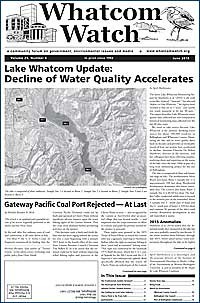by Fred Felleman
The Salish Sea was just given a reprieve. We are indebted to the Lummi Nation for exercising their Treaty rights that resulted in the U.S. Army Corps protecting the Cherry Point Reach in their May 9 permit denial of the proposed Gateway Pacific coal terminal.
Cherry Point’s deep, near shore waters are a mixed blessing. They form a key migratory corridor for the state’s genetically distinct — and once largest — stock of herring that supports the Lummi Nation’s ability to fish in their treaty-protected area. But these waters also allow deep-draft ships to dock close to shore.
The corps’ decision, under review since 2015, culminated a process begun in 1999. The corps concluded that the proposed terminal would restrict the tribe’s access to its fishery but did not consider the oil spill risk associated with the 487 coal ships — some twice the size of oil tankers allowed to call on the Salish Sea.
Stopping Gateway contributed significantly towards saving the Salish Sea from one incision in its death by a thousand cuts. However, it is still at risk from numerous impending permit decisions — two are highlighted below.
First, dampening the celebration of the corp’s decision, on May 20 the National Energy Board of Canada recommended that the Trudeau administration allow Kinder Morgan to triple the capacity of its Trans Mountain pipeline connecting the enormous tar sands reserves in Alberta with its marine terminal near Vancouver in Burnaby, British Columbia. This would increase the pipeline’s capacity from 300,000 to 890,000 barrels daily — even larger than the defeated Keystone pipeline.
Trans Mountain would, among other things, create a seven-fold increase in oil tankers plying the waters between Washington and British Columbia from one a week to one every day. The route taken by these tankers, laden with 25 million gallons of crude oil derived from unrecoverable tar sands, overlaps the critical habitat of the endangered Southern Resident killer whale community and endangered chinook salmon on which they depend. The final permitting decision is within six months. In the meantime, the public must contact Congress urging Trudeau to stop such a dangerous proposal from imperiling the Salish Sea.
Second, in 2001 the corps issued a permit allowing BP to double the berthing capacity of its tanker dock at its Cherry Point refinery without first conducting an Environmental Impact Statement. We environmental plaintiffs lost our permit challenge in U.S. District Court and the dock was built. But in 2005, the 9th U.S. Circuit Court of Appeals directed the corps to prepare an EIS after ruling the corps’ permit violated the National Environmental Policy Act and, potentially, the Magnuson Amendment (Ocean Advocates v. Corps, 402 F.3d 846, 872 (9th Cir. 2005).
The Magnuson Amendment, 33 U.S.C. § 476(b), prohibits federal agencies from issuing a permit that “will or may result in any increase in the volume of crude oil capable of being handled at” any facility east of Port Angeles, relative to its capability in 1977, unless for in-state consumption.
Following the court’s ruling, the corps took nearly nine years to produce a draft EIS of the dock proposal. The draft EIS revealed that an increase in tanker traffic had already occurred — from a historic high of 125 crude oil tankers a year prior to the 2001 expansion, to 138 in 2013. The EIS concluded that the new terminal could handle almost three times that number. However, the draft EIS failed to reach the inescapable conclusion that the permit violated the Magnuson Amendment.
Rather than removing the dock, the corps must limit vessel traffic to the original terminal’s maximum capacity. The public must demand that Congress direct the corps to finally complete the EIS and conclude the permit violates the Magnuson Amendment.
The corp’s recent decision on the Gateway Pacific Terminal was well worth the wait, but we have waited far too long for the corps to complete their EIS for the BP dock. Until it does, Cherry Point is far from safe.
_________________________________
Fred Felleman, MSc. is the NW Consultant for Friends of the Earth. He has spent over 25 years working to conserve the Pacific Northwest’s marine environment through research, photography and advocacy. He was elected to the Seattle Port Commission in November 2015.




























